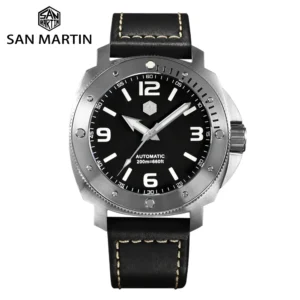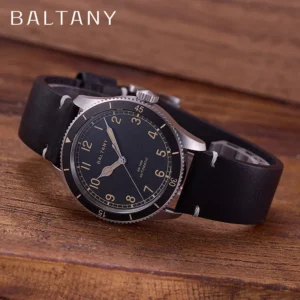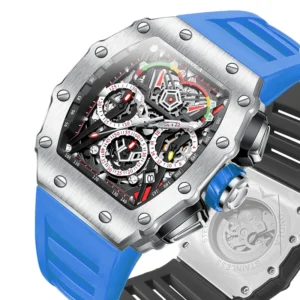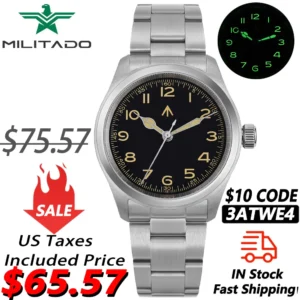Introduction
When venturing into the great outdoors, your timepiece becomes more than just a way to tell time—it transforms into a critical piece of gear that must withstand whatever nature throws its way. The material of your watch case plays a pivotal role in determining how your timepiece will perform in challenging conditions. Whether you’re scaling mountains, exploring underwater realms, or trekking through harsh terrain, the right watch case material makes all the difference between a reliable companion and a liability.
Outdoor watch cases must strike a delicate balance between several competing factors: durability to withstand impacts and abrasions, corrosion resistance against sweat and water, appropriate weight for comfort during extended wear, and aesthetic appeal that matches your style. These timepieces face demanding conditions that regular watches simply aren’t designed to handle—from dramatic temperature fluctuations to constant exposure to moisture, dirt, and physical impacts.
At Sharp Aspect, our expertise in curating exceptional mechanical timepieces has given us deep insights into how different materials perform in challenging environments. Our experience with rugged watch cases for outdoor adventures has shown that material selection significantly impacts performance, longevity, and user satisfaction.
This comprehensive guide will explore the most effective materials for outdoor watch cases, examining their properties, advantages, limitations, and ideal applications to help you make an informed decision for your specific adventure needs:
- Premium stainless steel varieties
- Lightweight yet durable titanium
- Nearly scratch-proof ceramic
- Advanced carbon fiber composites
- Practical polymers and resins
- Distinctive specialty metals like bronze
Key Factors for Selecting Outdoor Watch Case Materials
Before diving into specific materials, it’s essential to understand the critical properties that determine a watch case’s suitability for outdoor use. These factors often involve trade-offs—what you gain in one area, you might sacrifice in another. Different outdoor pursuits also demand different priorities in material selection, and mechanical watch movements require special consideration for protection.
When evaluating materials for outdoor watch cases, consider these crucial factors:
Durability and Impact Resistance: This refers to a material’s ability to withstand shocks without deforming or breaking. The Mohs hardness scale (rating 1-10) helps measure a material’s scratch resistance, while tensile strength indicates how much force it can withstand before breaking. Materials with good shock absorption protect not just the case but the delicate movement inside.
Scratch and Abrasion Resistance: Surface hardness determines how easily a material shows scratches, which is different from structural durability. Some materials might be incredibly strong but show surface marks easily, while others maintain a pristine appearance despite rough handling.
Corrosion and Water Resistance: Outdoor watches face diverse environmental challenges—from saltwater and chlorine to sweat and rain. Materials vary dramatically in how they resist these corrosive elements, which affects both performance and appearance over time.
Weight and Comfort: A watch that feels comfortable during a brief try-on might become unbearably heavy during extended activities. The material’s density directly impacts wearability during long adventures.
Temperature Stability: Extreme environments can cause some materials to expand, contract, or even become brittle. Quality outdoor watch materials maintain their properties across a wide temperature range.
Hypoallergenic Properties: For those with sensitive skin, certain metals can cause irritation or allergic reactions, particularly those containing nickel. Some materials offer natural hypoallergenic benefits.
Maintenance Requirements: Some materials require regular care to maintain their properties and appearance, while others are practically maintenance-free. This practicality factor becomes important during extended expeditions.
Value Proposition: Often, there’s a correlation between price and performance. Understanding this relationship helps determine whether a premium material justifies its higher cost for your specific needs.
Understanding these durability factors in rugged watches provides the foundation for evaluating each material option. With these criteria established, let’s explore the specific materials that dominate the outdoor watch landscape.
Premium Stainless Steel: The Versatile Classic
Stainless steel remains the most widely used material for quality watch cases—and for good reason. Its exceptional combination of durability, corrosion resistance, and cost-effectiveness makes it a versatile choice for outdoor timepieces. However, not all stainless steel is created equal.
The two primary grades used in premium watch cases are 316L and 904L. The more common 316L (also called “marine-grade” or “surgical steel”) contains molybdenum, which provides excellent resistance to chloride environments like saltwater. The more exclusive 904L, used by only a handful of luxury manufacturers, offers slightly superior corrosion resistance and a distinctive luster but comes at a significantly higher price.
The finishing technique applied to stainless steel dramatically affects both its appearance and practical performance. Polished surfaces provide a brilliant shine but show scratches more readily. Brushed finishes mask minor scratches better and reduce glare—a practical benefit during outdoor activities. Bead-blasted finishes create a matte appearance that’s both tactical and resistant to showing minor wear.
Steel’s performance in outdoor conditions is remarkably consistent. It handles temperature extremes with minimal expansion or contraction, resists most corrosive elements effectively, and can withstand significant impacts without deformation. While heavier than some alternatives, its density provides a reassuring solidity that many adventurers appreciate.
Understanding the properties and benefits of titanium watch materials can help you better appreciate the distinct advantages steel offers in comparison:
Pros of Stainless Steel:
– Excellent balance of durability and value
– Superior corrosion resistance, particularly with 316L and higher grades
– Versatile aesthetic with multiple finishing options
– Can be refinished to remove scratches and restore appearance
– Excellent magnetic resistance (important for preserving mechanical movement accuracy)
Cons of Stainless Steel:
– Heavier than titanium, carbon fiber, or polymer alternatives
– Polished surfaces show scratches more visibly
– Small percentage of users may experience skin irritation (though reduced with 316L)
Many iconic outdoor and tool watches—from historic explorer models to modern diving instruments—rely on stainless steel for its proven performance record. Its ability to be machined precisely, take different finishes, and withstand decades of use makes it the baseline against which all other watch case materials are measured.
Titanium: The Lightweight Performance Champion
When weight becomes a critical factor without wanting to compromise on durability, titanium emerges as the standout material for outdoor watch cases. This aerospace-grade metal offers an exceptional balance of properties that make it increasingly popular for premium adventure timepieces.
Watchmakers typically use either Grade 2 (commercially pure) or Grade 5 (Ti-6Al-4V) titanium. Grade 2 is more commonly used and offers excellent corrosion resistance with a distinctive gray appearance. Grade 5, an alloy containing aluminum and vanadium, provides superior strength and can take a higher polish but comes at a higher manufacturing cost.
The most immediately noticeable advantage of titanium is its remarkable weight reduction—approximately 40% lighter than stainless steel with comparable strength. This makes titanium watches significantly more comfortable during extended wear, reducing wrist fatigue on long expeditions. The material also naturally feels warm against the skin rather than cold like steel, a subtle but appreciated quality in freezing environments.
Titanium’s corrosion resistance exceeds even that of high-grade stainless steel. It creates a natural oxide layer that provides exceptional protection against saltwater, chemicals, and bodily fluids. This property makes titanium watches ideal for marine environments, tropical climates, and situations involving frequent exposure to sweat.
For those with metal allergies, titanium offers another significant advantage. Unlike steel, which can contain nickel that causes skin reactions in sensitive individuals, titanium is completely hypoallergenic and scratch-resistant, though it can still show surface marks over time.
Our collection of titanium automatic watches showcases how this remarkable material enhances the outdoor watch experience through its performance properties:
Pros of Titanium:
– Dramatically lighter than steel (40% weight reduction) while maintaining strength
– Exceptional corrosion resistance in all environments
– Completely hypoallergenic for sensitive skin
– High tensile strength and structural durability
– Naturally warm to touch, more comfortable in cold conditions
– Distinctive matte appearance with unique gray coloration
Cons of Titanium:
– Higher cost than comparable stainless steel models
– More susceptible to surface scratches (though they tend to be less visible)
– More difficult to machine, finish, and repair
– Limited finishing options compared to steel’s versatility
Titanium has become the material of choice for serious mountaineering watches, professional diving instruments, and military-specification timepieces where every gram matters but performance cannot be compromised. Its unique combination of properties positions it as the perfect middle ground between steel’s affordability and ceramic’s scratch resistance.
Ceramic: Virtually Scratch-Proof Sophistication
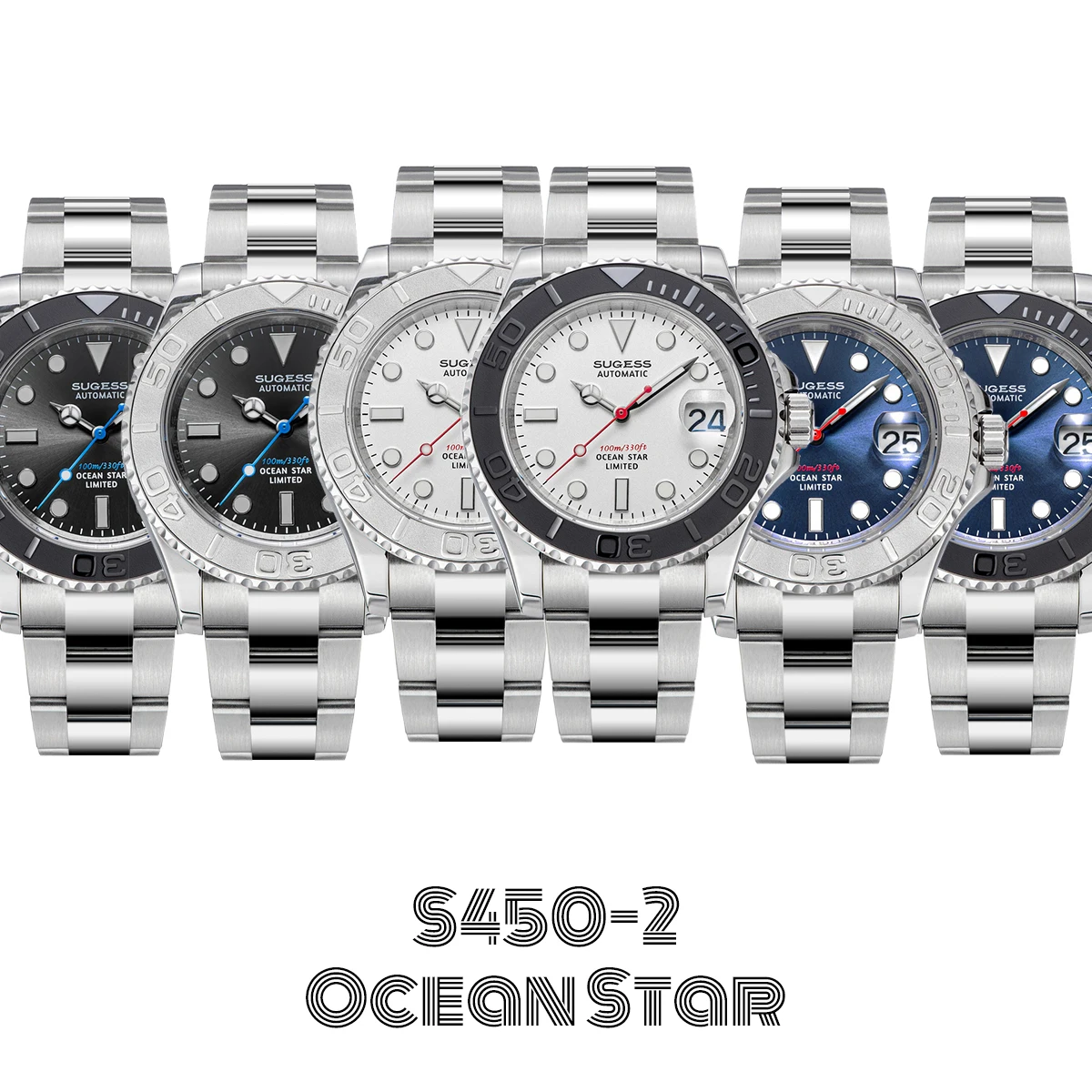
Modern ceramic watch cases represent the pinnacle of scratch resistance in horology. These aren’t your household ceramics but advanced zirconia-based compounds engineered specifically for watchmaking. The manufacturing process involves compressing powdered zirconia under extreme pressure, then heating it to temperatures approaching 3,000°F to create an incredibly dense, hard material.
What makes ceramic extraordinary is its remarkable hardness—typically registering around 8-9 on the Mohs scale, where diamond is 10. This places it among the hardest substances used in watchmaking, making it virtually immune to scratches from everyday encounters with metal, stone, or abrasive surfaces. For outdoor enthusiasts who want their timepiece to maintain a pristine appearance despite rough treatment, ceramic offers unmatched surface durability.
Ceramic watch components also weigh significantly less than their steel counterparts—about 30% lighter—while offering complete corrosion resistance. Unlike metals, ceramic won’t react to saltwater, chlorine, UV exposure, or any chemicals you might encounter outdoors. This makes ceramic particularly well-suited for diving watches and tropical adventures, as seen in many of our professional-spec dive watches.
Another distinctive advantage of ceramic is the color possibilities it offers. Unlike metals that require coatings to achieve different colors, ceramic can be colored throughout its entire structure during manufacturing. This means the color will never fade or wear off, even after decades of use. From deep blacks and navy blues to striking whites and even vibrant colors, ceramic provides aesthetic options that metals simply cannot match.
Pros of Ceramic:
– Nearly impervious to scratches with hardness approaching diamond
– Lightweight comfort for extended wear
– Complete immunity to corrosion, chemicals, and UV degradation
– Naturally hypoallergenic for all skin types
– Available in various colors that remain permanent throughout the material
– Modern, sophisticated aesthetic appeal
Cons of Ceramic:
– Brittle nature makes it vulnerable to chipping or cracking upon sharp impacts
– Expensive manufacturing process increases watch cost
– Cannot be easily repaired if damaged—typically requires complete replacement
– Generally limited to higher-end watch categories
While ceramic excels at resisting surface damage, its brittleness represents its Achilles’ heel for extreme outdoor use. A direct impact that might merely dent steel or titanium could potentially crack ceramic. This characteristic makes pure ceramic cases better suited to active lifestyles with moderate impact risk rather than extreme sports or tactical applications where impacts are more likely.
Many manufacturers address this limitation by creating hybrid designs—using ceramic for bezels or case components while maintaining a metal structure for impact resistance. This approach combines ceramic’s scratch resistance with metal’s structural integrity.
Carbon Fiber and Composites: Advanced Engineering for Extreme Conditions
When pushing the boundaries of material performance for extreme environments, advanced carbon composites deliver exceptional capabilities. These high-tech materials have revolutionized the watch industry by providing unprecedented strength-to-weight ratios and distinctive aesthetic properties.
Unlike traditional materials, carbon composites come in several distinct varieties, each with unique characteristics:
Traditional carbon fiber features the distinctive woven pattern many associate with high-performance equipment. In watches, it’s typically layered with epoxy resin to create a rigid, lightweight structure. The resulting material is incredibly strong in the direction of the fibers while maintaining minimal weight.
Forged carbon represents a more recent innovation, created by compressing carbon fibers with resin under extreme heat and pressure. This produces a marbled, organic appearance completely different from traditional carbon fiber’s woven look. Each piece develops a unique pattern, making every watch case one-of-a-kind.
Carbon TPT (Thin Ply Technology) involves stacking hundreds of microscopically thin carbon fiber layers at specific angles, then compressing them with colored resin. This creates a distinctive striped appearance while providing exceptional structural integrity in all directions.
Carbon-ceramic composites combine carbon’s lightweight properties with ceramic’s hardness to address specific performance needs. These hybrid materials aim to minimize the limitations of each component while maximizing their strengths.
The performance advantages of carbon composites are most apparent in extreme conditions. They maintain their structural properties across an incredible temperature range—from arctic cold to desert heat—without becoming brittle or expanding. Their natural shock absorption capabilities also provide superior protection for delicate mechanical movements, making them ideal for outdoor-ready watch cases.
Pros of Carbon Composites:
– Exceptionally lightweight (up to 60% lighter than steel)
– Extremely high strength-to-weight ratio
– Superior shock absorption and vibration dampening
– Complete immunity to corrosion
– Excellent stability across extreme temperature ranges
– Distinctive high-tech aesthetic appeal
– Natural movement protection through vibration dampening
Cons of Carbon Composites:
– Premium price point due to complex manufacturing
– Not as scratch-resistant as ceramic
– Limited repairability for surface damage
– Modern aesthetic may not appeal to traditionalists
Carbon composite watches have found particular favor among explorers, extreme sports athletes, and professionals operating in challenging environments. Their ability to withstand dramatic temperature changes, absorb impacts, and maintain minimal weight makes them ideal companions for pushing human and technological limits.
Resin and Polycarbonate: Practical Durability for Active Use
Not all outdoor adventures require premium metal or composite watch cases. For many active pursuits, modern polymer materials offer practical advantages at more accessible price points. These materials—primarily high-grade resins and polycarbonates—provide specific benefits that even premium metals cannot match.
Modern watch-grade polymers bear little resemblance to the cheap plastics of earlier generations. Today’s engineered resins incorporate complex molecular structures and reinforcing elements that deliver impressive performance characteristics. Polycarbonate, for instance, offers impact resistance far exceeding that of any metal while maintaining clarity and dimensional stability.
The standout characteristic of polymer watch cases is their exceptional shock absorption. While a strong impact might dent metal or crack ceramic, quality polymer cases can flex slightly to absorb energy before returning to their original shape. This makes them ideal for high-impact activities where shock resistance in watches is the primary concern—from mountain biking and rock climbing to military applications.
Weight reduction represents another significant advantage. Polymer watches typically weigh 50-70% less than comparable steel models, reducing wrist fatigue during extended activities. This lightweight nature, combined with their natural electrical and thermal insulation properties, makes polymer watches particularly comfortable in extreme temperature environments where metals might become uncomfortably cold or hot against the skin.
Pros of Resin and Polycarbonate:
– Extremely lightweight for maximum comfort
– Superior shock absorption and impact resistance
– Highly affordable compared to metal alternatives
– Excellent resistance to water and most chemicals
– Available in various colors and design possibilities
– Won’t dent or deform permanently like metals can
Cons of Resin and Polycarbonate:
– Lower scratch resistance compared to metals or ceramic
– Can degrade over very long periods with extreme UV exposure
– Often perceived as less premium than metal options
– Limited repairability for surface scratches
Polymer watch cases have earned their place in many specialized applications. Military forces worldwide often select polymer-cased watches for their lightweight durability and non-reflective properties. Similarly, many extreme sports athletes choose polymer watches for their unmatched shock absorption and comfort during high-impact activities.
For users who prioritize practical performance over luxury materials, or for those seeking a dedicated timepiece for their most punishing adventures, polymer cases offer compelling advantages that even premium metals can’t provide.
Bronze and Specialty Metals: Character and Unique Properties
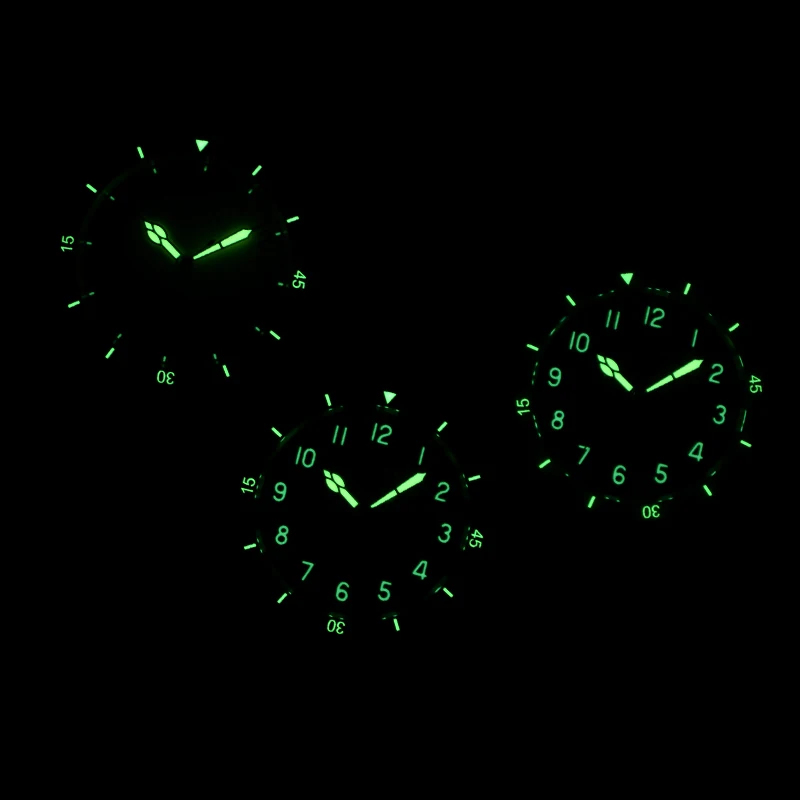
For adventurers seeking something beyond conventional materials, specialty metals offer distinctive characteristics and aesthetic appeal. Among these alternatives, bronze has emerged as a particularly popular choice for outdoor enthusiasts who appreciate its unique properties and living character.
Bronze used in watchmaking typically consists of copper alloyed with tin and sometimes small amounts of other elements like aluminum. Different bronze formulations offer varying properties—aluminum bronze provides enhanced hardness and corrosion resistance, while traditional tin bronze develops a more pronounced patina. What makes bronze special is its “living” nature—the surface reacts with oxygen, moisture, and the wearer’s skin to develop a unique patina that tells the story of the watch’s adventures.
In marine environments, bronze demonstrates exceptional performance characteristics. Historically used in shipbuilding and underwater equipment for its corrosion resistance in saltwater, bronze watches make ideal companions for diving and sailing. Unlike stainless steel, which can suffer from crevice corrosion in prolonged saltwater exposure, bronze develops a protective patina that actually enhances its resistance over time.
Our definitive guide to bronze watch cases explores how these timepieces develop character through use, making each one unique to its owner. Our collection of bronze automatic watches showcases this distinctive material in various designs.
Beyond bronze, other specialty metals offer unique properties for specific applications:
Tungsten carbide provides extraordinary hardness (8-9 on the Mohs scale) and scratch resistance nearly matching ceramic, but with greater density and a distinctive gunmetal appearance. Its extreme hardness makes it nearly impossible to scratch, though its brittleness requires careful case design.
Damascus steel, created through pattern welding different steel types, offers both visual distinction through its swirling patterns and practical performance benefits. Modern implementations combine corrosion-resistant steel varieties to create cases with unique aesthetics and excellent durability.
PVD (Physical Vapor Deposition) and DLC (Diamond-Like Carbon) coatings represent another approach to enhancing base metals. These microscopically thin layers can dramatically improve hardness, scratch resistance, and corrosion protection while offering color options like black, gold, or blue.
Pros of Bronze:
– Exceptional corrosion resistance in marine environments
– Develops unique patina reflecting individual use patterns
– Strong and durable construction
– Distinguished aesthetic with heritage appeal
– Natural antimicrobial properties beneficial for prolonged wear
Cons of Bronze:
– Relatively heavy (similar weight to stainless steel)
– Patina development may not appeal to those preferring unchanging appearance
– Can temporarily transfer oxide compounds to skin during wear
– Limited color options (various shades of brown/gold depending on alloy)
These specialty metals occupy particular niches in the outdoor watch market, appealing to enthusiasts who value distinctive appearance and specific performance attributes beyond what conventional materials provide.
Material Comparison: Selecting the Right Watch Case for Your Adventure
With so many excellent material options available, selecting the right watch case for your specific outdoor needs requires careful consideration of your priorities and typical activities. This comparative analysis will help match materials to adventures:
| Material | Durability | Weight | Scratch Resistance | Corrosion Resistance | Impact Resistance | Hypoallergenic | Cost | Temperature Stability | Maintenance |
|---|---|---|---|---|---|---|---|---|---|
| Stainless Steel | High | High | Moderate | Good-Excellent | Excellent | Moderate | $-$$ | Excellent | Low-Moderate |
| Titanium | High | Low | Moderate | Excellent | High | Excellent | $$-$$$ | Excellent | Low |
| Ceramic | Moderate | Low | Excellent | Excellent | Poor | Excellent | $$$-$$$$ | Good | Low |
| Carbon Composites | High | Very Low | Good | Excellent | Excellent | Excellent | $$$-$$$$ | Excellent | Low |
| Polymers | Moderate | Very Low | Poor | Excellent | Excellent | Excellent | $ | Moderate | Low |
| Bronze | High | High | Moderate | Excellent (marine) | Excellent | Poor-Moderate | $$-$$$ | Good | Moderate-High |
Different outdoor pursuits place different demands on your timepiece. Consider these activity-based recommendations:
For diving and water sports, prioritize exceptional water resistance and corrosion protection. Bronze excels in saltwater environments, developing a protective patina, while titanium offers the best combination of corrosion resistance and lightweight comfort. Ceramic bezels provide excellent protection against scratches from sand and salt crystals.
Hiking and backpacking demands a balance of durability and weight. Titanium offers the best combination of these properties, providing excellent strength while minimizing the burden during long treks. For ultralight backpacking where every gram matters, polymer or carbon composite cases may be preferable.
Mountaineering and extreme environments require materials that maintain their properties across dramatic temperature ranges. Titanium and carbon composites excel here, as they resist brittleness in extreme cold and maintain dimensional stability in heat. Their lightweight nature also reduces energy expenditure at altitude.
For tactical and survival situations, stealth and reliability take precedence. DLC-coated steel or titanium provides a non-reflective surface while maintaining durability. Polymer cases offer the advantage of being non-conductive and unaffected by extreme temperatures.
When selecting a watch for an everyday active lifestyle that includes occasional adventures, versatility becomes key. Premium stainless steel offers the best all-around performance, with enough durability for most activities while maintaining an aesthetic that transitions well between environments. Our rugged automatic watches demonstrate how quality materials enhance both daily wear and outdoor performance.
The right material choice ultimately comes down to understanding your specific needs and priorities. By choosing the perfect watch for outdoor adventures, you ensure a timepiece that serves as a reliable tool rather than a liability when you need it most.
Military Inspired Automatic Watches, Rugged Automatic Watches, Tactical Automatic Watches
Price range: $852.14 through $994.60 Select options This product has multiple variants. The options may be chosen on the product pageBronze Automatic Watches, Military Inspired Automatic Watches, Professional Spec Dive Watches
Price range: $1,442.21 through $1,442.82 Select options This product has multiple variants. The options may be chosen on the product pageProfessional Spec Dive Watches, Titanium Automatic Watches
$574.74 Select options This product has multiple variants. The options may be chosen on the product pageClassic Pilot Watches, Military Inspired Automatic Watches
$561.00 Select options This product has multiple variants. The options may be chosen on the product pageRugged Automatic Watches, Unique Automatic Watches
Price range: $228.96 through $231.10 Select options This product has multiple variants. The options may be chosen on the product pageClassic Field Watches, Military Inspired Automatic Watches
Price range: $280.87 through $338.51 Select options This product has multiple variants. The options may be chosen on the product page
Beyond the Case: Crystal Materials and Other Critical Components
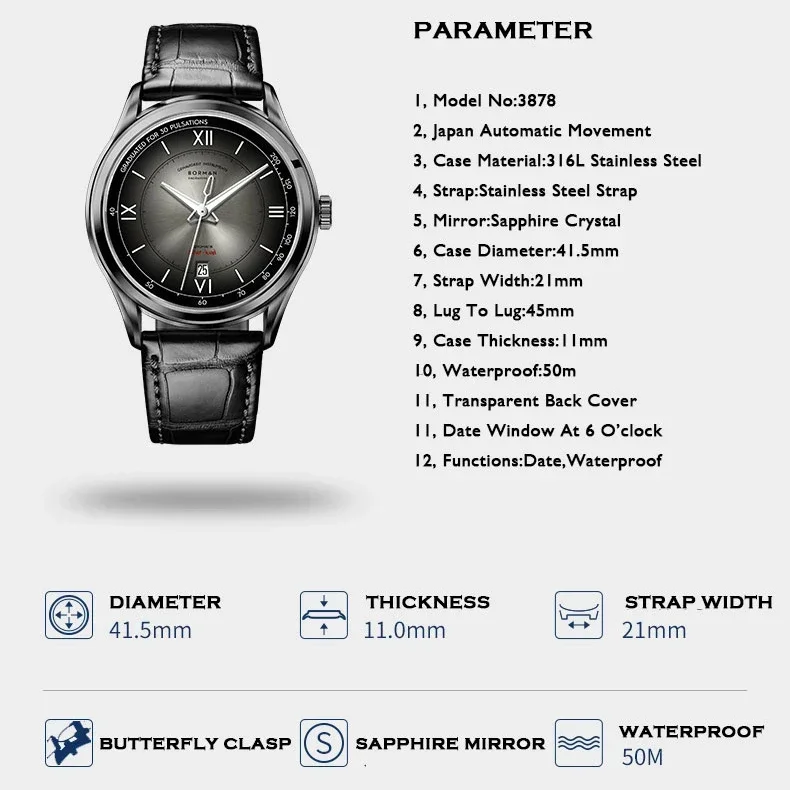
While the case material forms the foundation of a watch’s durability, other components play equally critical roles in determining overall performance. The crystal, in particular, represents a potential weak point if not properly matched to the intended use.
Watch crystals come in three primary materials, each with distinct characteristics:
Sapphire crystal offers nearly unsurpassable scratch resistance, rating 9 on the Mohs scale (just below diamond). This synthetic sapphire provides exceptional clarity and scratch protection but can be more prone to shattering upon sharp impacts. Most premium outdoor watches use sapphire for its ability to remain clear and unmarked through years of adventure. Anti-reflective coatings often enhance visibility, though these coatings can sometimes show wear before the crystal itself.
Mineral glass (sometimes called hardened mineral crystal) provides a middle ground between scratch resistance and impact tolerance. Chemically treated to enhance hardness, it resists scratches better than acrylic while offering greater shatter resistance than sapphire. Many mid-range outdoor watches use mineral crystal as a practical compromise.
Acrylic/Hesalite crystals offer superior impact resistance and won’t shatter like harder materials. While they scratch more easily, these scratches can be polished out with simple compounds. Some tactical and extreme-condition watches still use acrylic specifically for its shatter-resistant properties.
The strap or bracelet material also significantly impacts outdoor performance. Metal bracelets in matching case materials provide durability and security but add weight. Rubber or silicone straps offer waterproof performance and comfort in wet conditions. Nylon NATO-style straps provide security with quick-drying properties, while leather offers comfort with less ideal water resistance. Many automatic field and military watches feature easily changeable straps to adapt to different environments.
For mechanical watches, the case material’s shock absorption properties directly affect movement protection. Carbon composites and polymers naturally dampen vibrations, while metals may require additional shock protection systems. Similarly, materials with natural antimagnetic properties help preserve movement accuracy in environments with electronic equipment.
The holistic approach to material selection considers how all these components work together as a system, rather than focusing solely on the case material in isolation.
Maintaining Your Outdoor Watch: Material-Specific Care Tips
Each case material requires specific maintenance approaches to ensure longevity and optimal performance through years of adventure:
Stainless Steel:
– Rinse with fresh water after saltwater exposure
– Clean periodically with mild soap and soft brush, especially in bracelet links
– Minor scratches on brushed finishes can be addressed with fine abrasive pads
– Polished surfaces may require professional refinishing for scratches
Titanium:
– Extremely low maintenance due to natural corrosion resistance
– Rinse with fresh water after exposure to salt or chemicals
– Light scratches are often less visible than on steel due to color
– Most surface marks can be addressed with gentle polishing cloths
– Be aware that refinishing requires specialized equipment due to titanium’s hardness
Ceramic:
– Requires minimal maintenance beyond occasional cleaning
– Cannot be scratched by normal cleaning materials
– Avoid sharp impacts that could potentially chip or crack the material
– Cannot be repaired if cracked—requires component replacement
Carbon Composites:
– Clean with fresh water and mild soap when needed
– Avoid extended exposure to solvents that could potentially affect resins
– Surface abrasions typically blend with the material’s pattern over time
– Professional repair options limited—damage usually requires component replacement
Polymers:
– Clean with fresh water and mild soap
– Avoid extended exposure to harsh chemicals that can degrade the material
– Protect from prolonged direct sunlight to prevent UV degradation
– Minor surface scratches can sometimes be improved with plastic polishing compounds
Bronze:
– Decide whether you want to maintain the original finish or develop patina
– To preserve original finish, clean regularly with mild soap
– To maintain developed patina, simply rinse with fresh water after saltwater exposure
– Lemon juice or similar mild acids can restore brightness if desired
– Commercial bronze cleaners available for deeper cleaning
For all watches, regardless of material, proper care after saltwater exposure is critical. Always rinse thoroughly with fresh water, ensuring you flush out areas between the case and bezel or crown. Many professional tactical automatic watches feature designs specifically to make this maintenance process easier.
Regular inspection of seals and gaskets helps maintain water resistance. Even the most corrosion-resistant materials won’t protect a watch movement if water penetrates through deteriorated seals. Following manufacturer recommendations for pressure testing and seal replacement ensures continued protection.
How Sharp Aspect Selects Premium Materials for Outdoor Timepieces
At Sharp Aspect, our material selection philosophy centers on the perfect balance between performance, heritage, and long-term value. Rather than following trends or cutting costs, we evaluate materials based on how they enhance the foundational qualities of exceptional mechanical timepieces.
Our rigorous evaluation process examines multiple dimensions of material performance:
- Material Sourcing Standards: We ensure materials meet or exceed industry specifications for purity and consistency
- Finishing Quality Requirements: Each material must be capable of achieving and maintaining the fine finishing details that distinguish exceptional timepieces
- Durability Testing: Materials undergo simulated aging and stress tests to predict decades of performance
- Movement Compatibility: We assess how each material’s properties complement and protect mechanical movements
This comprehensive approach reflects our core “Time. Precision. Heritage.” philosophy. We believe that material selection directly influences how a mechanical watch expresses these values—from the precision enabled by proper movement protection to the heritage reflected in materials that age gracefully.
Our material choices aim to enhance the unique characteristics of mechanical timepieces rather than simply chasing specifications. We recognize that a watch made to last generations requires materials that maintain both function and beauty throughout decades of adventure.
By understanding the distinct properties of each material and matching them carefully to intended use, Sharp Aspect creates timepieces that serve as reliable companions for life’s adventures—whether you’re exploring underwater worlds, scaling mountains, or simply navigating daily challenges.


